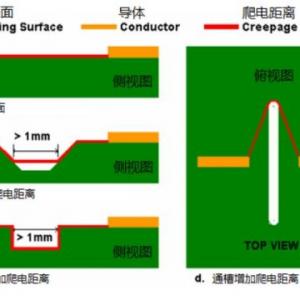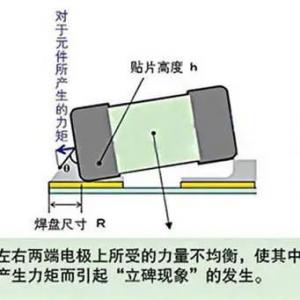Nickel-plated pins are difficult to solder and the tin penetration is poor. Is there any good solution?
Vx-sh: It is very difficult to automatically solder the nickel-plated pins. The corresponding PCBA through-hole pad is made of nickel gold, and the tin penetration is very poor. Please tell me what a good way can be done (the soldering time does not exceed 6s, and the stability is lower than 380 ℃, SAC305 tin wire)
george tsao: Do an experiment and switch to manual soldering with a soldering iron to see if the conditions are the same. Then you can determine the cause... PCB nickel gold, is there a problem with the plating of the component pins? Take a photo of the board, parts, and defects after welding to see
Vx-sh: For the second pin, we require that the negative side also needs to be visible through the tin, as shown in the picture:

george tsao: Is this it? Is this the only problem with this foot?

Vx-sh: Correct grounding, the board is made of gold
george tsao: Grounding Let’s get to the point... Before soldering, place the soldering iron on the pad for 2 seconds or more. Add solder wire. You can also consider raising the temperature of the soldering iron to 400 degrees.
for ever: Use an air gun to preheat and then add tin, and the time should be controlled within 5 seconds@Vx-Sh
Liu Haiguang: You can use two soldering irons. The termination surface is only auxiliary heating without adding tin, and the starting surface is responsible for conventional welding. The temperature of the soldering iron on the starting surface is higher than the auxiliary heating soldering iron, forming a reasonable temperature difference to achieve the ideal welding parameters. When the through hole is fully tinned, Up to 75% withdrawal of auxiliary heating soldering iron @VX-SH
for ever: Mr. Liu, I often have this problem too. It’s very annoying. The two Luotie are difficult to operate @Li haiguang
george tsao: What I said earlier is that if your automatic welding machine uses a soldering iron and tin wire to weld one spot at a time, you can use a more powerful soldering iron and a thicker soldering iron head. In addition, the position where the soldering iron head contacts the welding point should be small. Very important. Many people are accustomed to using the watering method to solder. This can handle the solder joints of a signal circuit, but for grounding VCC solder joints, it is easy to not fill up the solder @VX-SH
Liu Haiguang: Solder joints that are easier to dissipate heat are usually treated this way. You can also use a small-diameter hot air gun with an air outlet of 150C to fix the position.
george tsao: Of course it would be better to have such a tool and to set it up together for use.
Li Hua: The constant temperature preheating table is used to preheat to about 140 degrees, then add tin @VX-SH
VX-SH: The customer requested that the welding temperature should not exceed 360 and the time should not exceed 5 seconds. It was not possible. Now the temperature is 395 and the time is 10 seconds. After preheating, the effect is not very good @li hua
Li Hua: This kind of soldering is common in selective soldering. It is used to heat the large copper plate directly with the wave peak for a few seconds before soldering. Just like the examples given by Teacher Liu and Teacher Cao, try applying rosin paste on the pin.
VX-SH: Nickel plated, poor solderability, difficult to achieve with dual soldering irons, 200W WEILLER, thick head with grooves, tried adding rosin, but the effect was not good. It’s not convenient for batch production @li hua
george tsao: Ask the customer why the soldering iron temperature cannot exceed 360? Many times, even customers cannot figure out the basics. Nonsense... If there is no problem with the soldering of other parts, it may not necessarily be related to the nickel plating. The key point is the temperature @VX-SH
Li Hua: Test the component pins by pre-dipping tin. We also have Ni-plated components and use selective soldering. Occasionally there are problems. Your problem should be that the copper ground temperature is not enough. If the Tg of the board is high, constant temperature preheating and increasing it should be ok. @VX-SH
george tsao: Even if the nickel plating layer is oxidized, the liquid solder can flow along the pins to the surface, but whether it is actually soldered is another matter. If the solder cannot flow, first look at the temperature. If it still doesn't work, remove the soldering iron. Increase it to 250w and try it. You will first consider the nickel plating issue. Take a separate part and directly use a soldering iron and tin wire to see if the solder can spread on the surface of the pin. Do not insert the part into the board.
VX-SH: It only has 200W and can only increase the preheating temperature. Please tell me again, at what degree and for how long does the actual solder joint temperature remain? Reference wave soldering?
george tsao: There is a big difference between wave soldering and soldering iron welding. There is basically no preheating for soldering iron soldering. The temperature of the soldering iron is quickly absorbed by the large copper foil when it comes into contact with the solder joint, and the solder cools down accordingly. So as mentioned above, the main thing is to Only by raising the temperature of the solder joint first and then welding can the solder be maintained in a better liquid state for welding. The power of the soldering iron is low and the heat conduction is insufficient. We have to increase the temperature to make up for it and extend the welding time. However, if the temperature is raised too high and the welding time is long, it will cause greater damage to the base material @VX-SH
Liu Haiguang: The classic saying that you should try welding and soldering yourself is - the flux runs to low temperatures and the solder runs to high temperatures. The first step in wetting is flux. The establishment of a thermal bridge first refers to flux, and then to molten solder. , the pins will not be all nickel, but tin-nickel alloy. It needs simple tooling to position the PCBA, and auxiliary heating can be used for positioning, so it can be operated by one person @VX-SH
george tsao: The soldering iron should first contact the solder joint, preheat it, and then add the tin wire. Do not add the tin wire too quickly, otherwise the high temperature will kill the flux... Another point is that if the solder demand is large, use a thicker tin wire.
Li Hua: There are some all-nickel ones. I came across one. The four shell pins are plated with bright nickel, and the functional pins are plated with nickel and tin. The shell pins are connected to the ground. In a big box, the four pins can only reach about 70% of the filling height. , when you encounter nickel-plated pins, you can only try all methods to find the best way to solve it. It won’t work in large quantities, but it will work in small quantities @VX-SH
Liu Haiguang: At this time, an OKI or Kuak high-frequency soldering iron may solve the problem. With any equipment, you can only change the soldering time. The temperature of the leaded board should not be too high.
Li Hua: I have three here, which are often used to disassemble and assemble power modules during rework.
Liu Haiguang: Yes, everyone who has used it says it is good, @li hua
Liao Xiaobo: When we develop and produce power supply and signal filters (filter components), we need to "ground them nearby." Therefore, our product casings use a large number of aluminum alloy (lightweight) nickel-plated (solderable) structures so that the filter circuit can be grounded and welded anywhere during the assembly process. As a result, we have accumulated a lot of experience in welding nickel-plated parts. From our experience, this kind of welding must use a high-frequency power supply soldering station with rapid temperature recovery characteristics, and the power of the soldering station should be large enough depending on the heat dissipation characteristics of the chassis. Although using a constant temperature preheating platform as an auxiliary work suspension is also a way to solve the problem, it is inconvenient after all. Our experience is that the welding performance of a 200W fast-heating high-frequency power supply soldering station far exceeds that of a 300W ordinary soldering iron.





